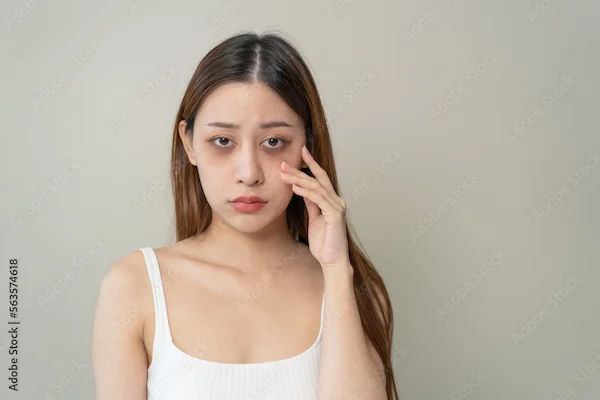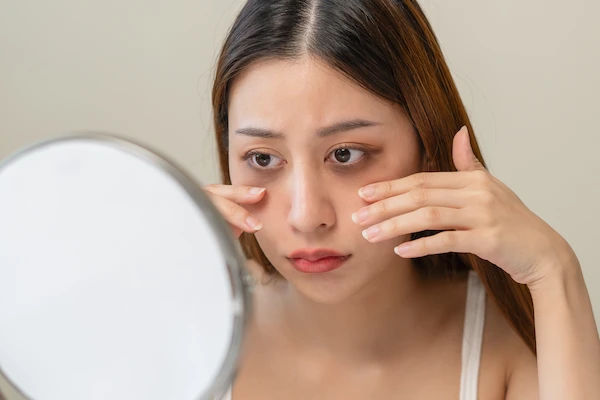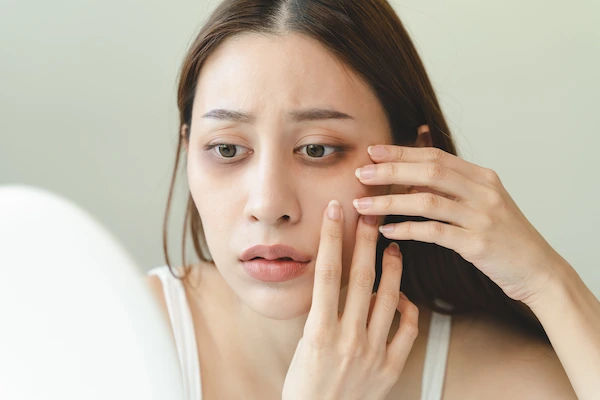Dark Circles Under Eyes
Dark circles under the eyes make the skin look dull. So, learn its causes, treatment, and strategies to get rid of it.

Written by Dr Sonia Bhatt
Last updated on 3rd Jul, 2025
Dark circles appear when the skin around the eyes becomes noticeably darker than the surrounding skin. Depending upon the natural skin colour, the dark circles might appear in black, brown, purple, or blue shades. This condition gives the impression of an individual being tired and exhausted and makes the person look older than they actually are. Contrary to popular belief, dark circles are not permanent, and they are not only caused by the lack of sleep. While sleep deprivation is a contributor, there is more to the arrival of dark circles than that.
Causes of Dark Circles
There are several reasons for the appearance of dark circles under the eyes. Here are some of the highlighting ones:
Genetics: One of the major reasons behind the appearance of dark circles is genetics and hereditary factors. People with a family history of this condition inherit it, while certain ethnic groups have pigmentation irregularities that contribute to the development of this condition.
Lifestyle Contributors: In terms of lifestyle contributors, sleep deprivation is one of the major contributors to the development of dark circles. Besides that, improper diet and chronic stress also further the development of this condition.
Medical Conditions: Sometimes, the blood vessels under the eyes dilate and show over the skin. This has happened due to eczema and contact dermatitis. It also leads to dark circles in the eyes.
Dehydration and Hyperpigmentation: These also cause dark circles. Dehydration makes the skin under the eyes look dull, and hyperpigmentation occurs due to prolonged sun exposure.
Types of Dark Circles
Generally, three types of dark circles have been observed in people. These are:
Pigmented Dark Circles: This type of dark circle occurs due to the extended production of melanin, which is caused by pigmentation on the skin.
Vascular Dark Circles: Vascular dark circles occur when veins become visible due to thinning facial skin, reduced fluid retention, and blood flow. Also, there will be puffiness under the eyes to accompany the dark circles.
Structural Dark Circles: This sub-type of dark circles appears due to the shadows from the formation of eye bags, skin laxity, and fat loss.
Symptoms Associated with Dark Circles
Dark circles under the eyes are quite common among people of different ages. Actually, the symptoms and causes of dark circles under the eyes are the same. Generally, they include the likes of sleeping disorders, stress, allergies, skin issues, and hereditary reasons.
In babies, dark circles under their eyes happen due to too much rubbing of eyes, fatigue, or genetics. Additional symptoms in babies may include ear infections, colds, or flu. Sometimes, dehydration and injuries can also cause dark circles in children.
Diagnosis
Accurate diagnosis of dark circles is crucial to identifying their underlying cause and deciding on the right treatment approach. This process starts with a thorough clinical evaluation by a dermatologist, where the expert reviews the medical history of the patient and his/her family. This helps the doctor identify hereditary factors or underlying conditions like allergies or eczema.
The dermatologist also performs a physical examination to assess the skin under the eye for pigmentation, texture, and vascular prominence. The doctor also asks questions about the patient's lifestyle to check for sleep deprivation, diet and stress levels, and skincare routine.
Together, this evaluation process helps the dermatologist determine the exact cause and type of dark circle one is subjected to. Based on this information, the doctor tailors the treatment plan.
Treatment Options
Based on the diagnosis, the dermatologist suggests the treatment, which includes the following:
Topical creams and skincare routines
The doctor might suggest a skin-lightening cream with kojic acid, azelaic acid, hydroquinone, or glycolic acid to lighten the hyperpigmentation under the eyes. Some of these creams are also available over-the-counter with a lower percentage of active ingredients.
Moreover, the doctor may suggest light chemical peels to brighten the dark pigmentation under the eyes. These peels include hydroquinone, retinoic acid, or glycolic acid.
Medical treatments
Laser treatments are commonly known strategies for lightening darker skin. This treatment targets the darker pigments under the eyes. It helps to vaporise the damaged skin cells with heat energy. Additionally, laser therapy aids in new collagen formation.
Sometimes, doctors suggest treatment with fillers. They inject a filler within the tissue under the eye that treats dark circles. They mostly use hyaluronic acid-based dermal fillers like Juvederm or Restylane.
Also, blepharoplasty helps decrease the shadow of the eyelid and causes dark circles. With this treatment, a plastic surgeon, dermatologic surgeon, or oculoplastic surgeon removes the fat from the lower eyelids.
Home remedies and lifestyle changes
Individuals need at least seven hours of sleep every night. It prevents the eyes from dark circles.
Applying cold compression can help shrink the dilated blood vessels. It also reduces the dark circles around the eyes and puffy eyelids.
As cucumbers have vitamin C and water, applying cucumber slices on the eyes also reduces the puffiness of eyelids.
Try to raise your head with extra pillows. This will prevent fluid from collecting under the eyes, which will reduce eye puffiness.
Facials with massaging around the eye areas become helpful for fluid circulation and prevent the skin from dark circles.
As tea incorporates antioxidants and caffeine, placing tea bags under the eyes will also be helpful.
Prevention Strategies
Some of the popular prevention strategies for dark circles include:
Readjusting the sleep routine with at least 7 to 8 hours of sleep.
Strategically manage the stress, such as scheduling self-care time, maintaining a work-life balance, etc.
Reducing consumption of alcohol and smoking
Use sunscreen (at least SPF 30) on the face, including the adjacent areas of the eyes. Also, wear sunglasses.
Treating underlying medical conditions such as melisma and eczema.
Take plenty of vitamin C, E, and K-rich foods. These include citrus foods, spinach, bell peppers, almonds, and broccoli.
When to See a Doctor
Dark circles in the eyes usually don't require medical attention, as individuals can use the home remedies and prevention strategies mentioned above to deal with them. However, if they notice swelling of the eye from dark circles, then they must get it checked, as it could be a sign of other underlying health issues.
Conclusion
Dark circles are not a serious medical condition, but they can make one look a certain way that is not always pleasing. They also give the impression of the individual being overworked, stressed, and extremely tired, which sometimes affects self-esteem. Therefore, knowing the causes of dark circles and risk factors can help people be aware of the condition and combat it with effective home remedies and prevention plans.
Consult Top Ophthalmologists
Consult Top Ophthalmologists

Dr Rajesh Rastogi
Ophthalmologist
33 Years • MBBS, MS Ophthalmology
New Delhi
Rotary Diabetic Centre, New Delhi
Dr. Padmini S
Ophthalmologist
4 Years • MBBS,MS
Bengaluru
Apollo Medical Center, Marathahalli, Bengaluru
Dr. V.chittibabu
Ophthalmologist
30 Years • MBBS, MS
Vellore
Krupa Eye Clinic, Vellore

Dr. Sneha T Khurana
Ophthalmologist
9 Years • MBBS, MS Ophthalmology
Gurugram
GS multispeciality clinic, Gurugram

Dr Deepti Govila
Ophthalmologist
26 Years • MBBS, MS Ophthalmology
Delhi
Apollo Hospitals Indraprastha, Delhi




